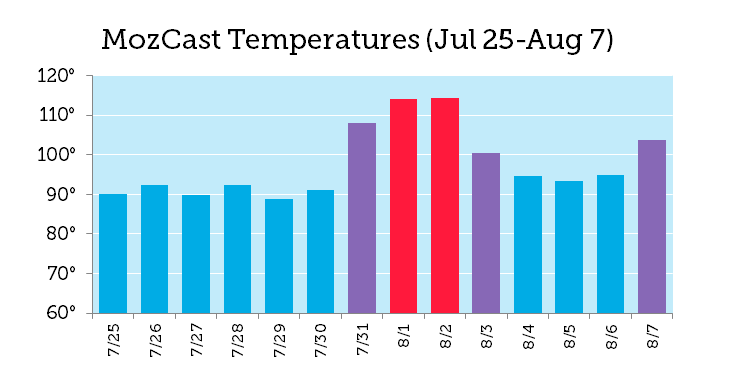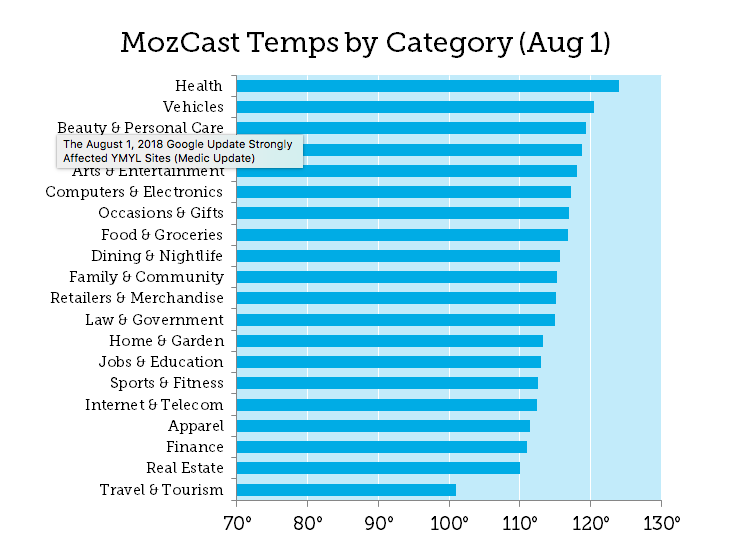Google is constantly updating its algorithm, oftentimes without even explicitly knowing. It uses machine learning to find patterns in the data and redefine rules based on these findings. For a while, we had gotten past the age of big, sudden algorithm changes with significant impact across the board, like Penguin and Panda, and had entered an age of marginal day-to-day algorithm optimization. Every once in a while we’d get a new factor revealed, like mobile-friendliness and load speed, but for the most part SEOs understood that if the content was better than its competitor’s then, all else equal, it would outrank those competitors.
Google’s August 2018 update, which is earning the moniker Medic, has come as a shock to many because of how drastic some of its effects have been. Some sites have “won,” but many have lost — losing positioning and organic search traffic volume. As the nickname suggests, the healthcare sector is one of the industries most affected by ‘Medic.’ Other industries have been impacted as well, mainly contained to what Google calls “Your Money, Your Life” websites.


The update’s effects haven’t been contained to an obvious group of websites. What I mean by “obvious” is a website with bad content, bad links, and very little effort to act as a useful resource for its audience. Websites that have for a long time done well on Google, dominating the search market for their relevant search queries, have suffered as well. Some have, in fact, been hit pretty hard.
Consider the following example,

This website has dominated the most relevant local dental implant terms with purchasing intent for almost 9 years. He accomplished this by adding new content, rewriting old content, and updating the website’s user experience on a month-to-month basis. He has a strong local brand, he is a highly trusted dental professional, and yet his website has lost positioning. Which site took his spot? An old website with plagiarized content.
Google’s cryptic advice to webmasters, when responding to professionals seeking guidelines on how to recover from the update, was to build “great content.” This is the same advice good SEOs have been following for several years now.
What this may suggest is that we should expect a good deal of positioning changes over the coming weeks. Maybe Google is experimenting? Maybe they’re still calibrating?
Still, there are applicable lessons here and this algorithm update may represent a wider scale effort to clean-up how businesses in the Your Life, Your Money industries market themselves. Google has enforced stricter rules on healthcare businesses running ads on Google and its display network for many years now. It’s not the only company, either. Facebook also has stricter rules for “Your Money, Your Life” businesses. These rules give us hints on what these companies like and dislike about healthcare marketing, so they offer us some guidance on the i’s worth dotting and t’s worth crossing if your site has been negatively affected by ‘Medic.’
Let’s talk about these rules and some other guidelines to keep in mind when marketing your practice. These guidelines focus on the healthcare industry but can be generalized to law, hospitality and tourism, and any other industry that has a direct influence on their customers’ livelihoods.
[optin-monster-shortcode id=”wbw80mm0fxs0v0dhpgku”]1. Avoid Empty Content
“Empty content” is a term I use when talking to my own team about writing high-quality content. It’s traditional to sell content by word count and sometimes to meet that word count marketers will write fluff. It’s not always obvious and extreme, sometimes it can be very subtle. Sometimes it’s hidden beneath jargon, and sometimes it’s statements that are circular and purposefully avoid a strong, tangible point.
For example, it’s common to write a financing page to rank for financing and cost terms. But when the content discusses cost, it says, “Cost can vary from individual to individual, depending on the number of implants needed and other factors.” This doesn’t actually help the patient, because the patient pretty much already knew this. You would, for example, never answer this way if the patient was sitting in your operatory chair, the answer would be more specific. What the patient wants is an average or some sort of bar to set their expectations at. If you’re not meeting that expectation, or if you’re taking them through loops, then the content is empty to them.
Good content has meaning and purpose, it has a reason for existing, a reason to be read. It adds value to somebody’s life, it helps them in their decision-making process, it compels them to action.
I used to write for several economics publications and one of the most useful pieces of feedback I ever got from an editor was, “Revise each sentence until it says exactly what you intend it to.”
And that’s exactly how web content should be written. Each page should have a tangible topic, a core message, and each paragraph on that page needs to support that core message. Content should be clear, efficient, and focused on adding value, never meandering and never wasting the reader’s time. It should address pain points, concerns, and questions in a direct way and with clarity.
Ask yourself, “If I was looking for this service, or if I was looking for information on this, would this content satisfy me or do I know there’s something better out there?”
There’s a lot of competition out there, the standards are high, and to compete these standards must be exceeded.
2. Solidify Your Online Brand with Local SEO
Every so often, Google surveys part of the web using a human team to evaluate web pages according to internal criteria. These criteria were released to the public.
For the medical industry and other Your Money, Your Life sectors, the E-A-T criteria have been one of the most frequently cited in reference to the August 2018 algorithm update. E-A-T stands for expertise, authoritativeness, and trustworthiness.
Sites under my watch have been affected and all of these sites are owned by real doctors who are often the most educated, most well-trained providers in their area. They meet the E-A-T standards. Yet, does Google know? Does their algorithm know what the International Congress of Oral Implantology are? If it does know what they are, are they attributing all the credit to the same person or is your online identity inconsistent?
The factors that weigh into how you perform on Google are no longer specific to your website. Many of them consider your overall online reputation. If your online identity is fractured and inconsistent, then Google may just not be able to properly gauge your trustworthiness.
If you or your business’ identities are inconsistent across the web, investing in a citation clean-up is a first step toward making sure you’re building that authority and making sure you’re getting credit for it.
3. Don’t Assume Anything is Common Knowledge (Cite Your Sources)
We started out the discussion by using a dental implant provider’s website, so it seems fitting to stick to dental implant examples.
There’s an oft-quoted statistic in most practitioners’ web resource on dental implants: they have a success rate of 98 percent. Which is true. But over what time frame? 5, 10, 15 years? For which teeth? Does this figure include only the implant itself or the prosthetic as well? A simple statistic like this one, so often quoted, can be so misleading because it’s devoid of context and definition.
There are some facts that are common knowledge. That you should brush your teeth at least twice a day and see the dentist around every six months, on average, is either common knowledge or close to it. Other claims, like how many people prefer implants to dentures, or the superiority of an oral device over a CPAP machine, is more nuanced. Your content should address this nuance and deliver an answer in a way that allows the visitor to apply this knowledge in an actionable way. Furthermore, any claims that are not common knowledge should be cited.
To clarify, I’m not saying that citing your work or linking out to other authoritative websites will increase your rankings or earn you more search traffic. What I’m saying is that uncited claims that are not common knowledge raise doubt and suspicion, they force the other person to corroborate it, and they may be the reason why Google doesn’t rate your authority and trustworthiness more highly.
4. The Power of Honesty and Transparency
Facebook does not allow you to boost before-and-afters. They don’t let you use before-and-afters to market your practice through their ad system. Google is also careful with before-and-afters, asking you to add a note that makes clear that this is an individual result and not what the prospect should necessarily expect.
If Google and Facebook can keep track of this when delivering your ads, it’s likely that Google can track the same information when determining how you rank. Your honesty and transparency in the content may play into E-A-T. It may help determine how Google weighs you in each of those categories (expertise, authoritativeness, and trustworthiness).
If you use before-and-afters on your website — and I still recommend that you do —, go the extra step and make sure to let the reader know that these results do not guarantee their own.
5. Don’t Fish For Emotion
It’s common for Facebook to reject ads that use the word “you.” Specifically, they don’t like it when the advertiser refers to “your” smile or “your” well being. They know what you’re doing, they know you’re trying to appeal directly to the reader and in a way that strikes an emotional chord.
The truth is, most patients don’t want to read highly technical content either. If they did, they would go to WebMD and other major websites with established reputations. A practice’s website talks about the service provides information on the service, but must also address why their practice is the one that the prospect should choose. That aspect of a website will always be emotional because people don’t buy what you sell, they buy why you sell it.
The line between good emotional copy and manipulatory content can be very subtle, and that line can be crossed in many ways.
Consider the following claim: “Our product can improve your life.” Can it? 100% sure? Or you are 90% sure or 50% sure? “Our product can improve your life 50% of the time” would be more accurate, but doesn’t sound as attractive. That’s the point, though. If you need to make a statement in a misleading way, then it probably wasn’t a good statement to make in the first place.
Similarly, consider: “Do you lack confidence in your smile?” From there you might pitch your service and why they should come see you. Maybe the person is unhappy with their smile, maybe not. First of all, unhappiness with their smile doesn’t mean they need what you’re selling. Second of all, there may be nothing wrong with their smile at all, they’re just self-conscious, and now you manipulated them into a sale. This type of copy is a big no-no in medical paid advertising, so it would make sense for the same companies (like Google) to crack down on these tactics’ on a wider scale.
Instead, hook the reader in with your unique selling proposition, something that makes you stand out and entices them to contact you.
6. Look at Your Marketing Holistically
I have a saying I use a lot with my team, “Google ranks pages, not websites.”
I use it to drive home the point that different pages on a website serve different purposes, address different needs, and therefore rank for different terms. If we’re not getting traffic for certain terms, we need to look at certain pages.
The website as a whole still matters, of course. As does your marketing as a whole. When Google talks about expertise, authority, and trust (E-A-T), they’re looking at this on a global level. I already mentioned how local SEO relates, but the same is true for reputation management (getting more 4- and 5-star reviews), your dynamic with the professional field (do you publish?), and the press your business gets. If you have more than one website, each of them can affect how Google rates your authoritativeness and this combined score can affect both sites. Meaning, a bad apple can cause the whole basket to rot. Or, maybe Google doesn’t have much to go on when determining your score, they may need more evidence.
Looking at your marketing from a higher, more comprehensive perspective is a good habit to get into, regardless. Each individual element in your marketing strategy doesn’t operate within a vacuum. These factors influence each other. Your visitors will typically find you over multiple touch points. They might have seen an ad first and then done a Google search. Or they might have found you on Google, then checked out your social media, and only then decided to call you.
The whole is greater than the sum of its parts.
7. Cross Your T’s & Dot Your I’s
The algorithm update may also have affected how different factors are weighted by the search engine. For example, maybe speed and security have become more important relative to other elements, in the same way that keyword optimization best practices changed over time.
Make sure your website is performing the best it can when it comes to:
- Security, including HTTPS and secure hosting
- Mobile-first design
- Page speed
- Content comprehensiveness and legibility
- Content recency (“freshness”)
- Backlink profile
- User friendliness, including experience-breaking pop-ups and ads
- Crawlability
Some of these issues are not easy fixes. Improving website speed isn’t always a question of installing a caching plugin or optimizing images, there may be deeper issues.
Consult with your agency on what the next steps for improving each of these elements are and what it takes.
8. Stay Competitive
Most people who were affected by the Medic update probably did nothing wrong. They were likely following best practices. Most experts don’t even know what exactly changed. This all reinforces the fact that to succeed in SEO you have to play the long game and you have to consciously remain competitive.
Content must be built out over time. The SEO world is dynamic, meaning that people in your market are also improving their own content and their own websites simultaneously. To stay ahead of the game you have to keep track of this and respond.
This means adjusting and adding content, rewriting on-page SEO elements like title tags and meta descriptions, continuously optimizing elements for speed and usability, et cetera. Outside of the narrow scope of SEO, you also have to remain competitive on a higher level, including press coverage, publications, and all the other factors that tie into your expertise, your business, and the brand you’re building. If you let your foot off the gas pedal, you may find yourself suddenly behind.
Barriers to entry are getting lower for many industries, especially on the web, and the competition is heating up. Stay on top of it.
No Easy Solution
If the old Penguin (penalizing bad links) and Panda (downgrading “thin content”) algorithm updates had clear targets, and more recent updates like Hummingbird and Caffeine had clear intentions, then so far Medic seems to be an update on a broader and therefore more ambiguous scale. It may have affected several variables or introduced new variables, and it may not even be about penalizing sites as much as it’s about getting a more accurate measurement of quality, trust, and authoritativeness.
Rather than focus on what was done wrong, we should look at where we can improve. We should look for opportunities to inspire and better apply our internal standards, the standards that define why we do what we do. We can’t control how others compete against us, but we can always strive to be the best version of ourselves.
